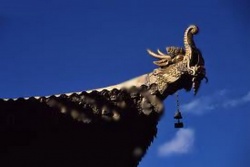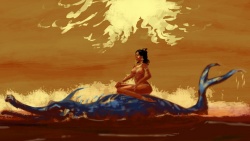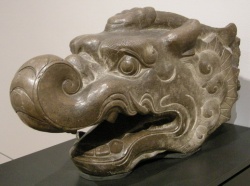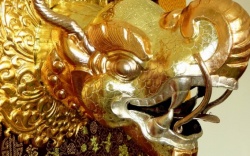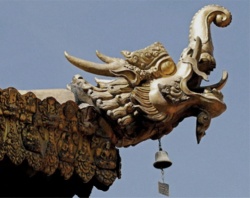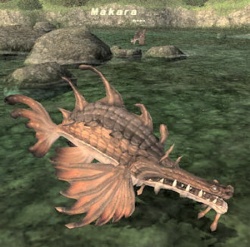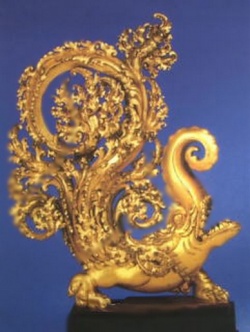Makara
Click here to see other articles relating to word Makara
The Sanskrit word makara (Skt. मकरः) can refer to the amphibian animal we know as the crocodile. However, it also designates a mythological water creature that resembles a croc in only one way it has a long proboscis [nose-like organ.] It is doubtful that someone would recognize in images and sculptures of makaras any crocodilian he or she had ever seen.
As this page was inspired by Year of the Water Horse, there are also references to other mysterious water creatures such as the Kelpie, the Silkie and the Seahorse because of certain common characteristics. For example, in the temple complex of Khajuraho in the north central Indian state of Madhya Pradesh, the guardian makara sculptures resemble sleek sorts of seals. They are chubby, smooth-coated creatures with short, re-curved trunks.
Now the trunk is the identifying characteristic of the elephant, and as we have seen, elephants are associated with the rain clouds that presage a plentiful harvest. Hence they are linked with Lakshmi, the Indian goddess of prosperity. This calendar art image shows how the elephant with raised trunk is related to the mythological water creature called makara.
Makara and elephant are linked in a Indian (Hindu) tale in the Bhagvata Purana: Once Gajendera, king of the elephants, was bathing with his herd. It was the king's custom to remain on guard while the rest made their way to shore, but this evening a crocodile, disturbed by the activity, grabbed one of Gajendera's legs and began to drag him under the water. The chief pachyderm, strong and experienced as he was, was unable to extricate himself from the vice-like jaws. In fear and agony, he called for help from the others, but even their combined effort was futile. Slowly and methodically the reptile dragged him under until his trunk could barely reach for air. Exhausted and defeated, the others gave up any hope of rescuing their leader. In desperation, Gajendera appealed to Lord Vishnu, who hearing the cry of His devotee, rushed to his aid on his vehicle, Garuda, and with a toss of his discus beheaded the crocodile.
Named "river horse" by the Greeks, the hippopotamus could even be the prototype for the makaras that accompany Ganga, goddess of heavenly sweet waters. Or, if ever there actually existed an animal resembling the makara as depicted beside the gates of medieval Indian temples then the gentle vegetarian manatee (Trichechus manatus) might even be a candidate.
In astrology, the makara is often translated Water Horse, and corresponds to the western astrological sign of Capricorn. It is serpentine or seal-like, and its elephantine head is often used as an architectural decoration or as a structural bracket.
In India, Makara-Shankranti occurs at the terminal cusp of Capricorn indicating that the sun is now entering the tenth house of the Zodiac and heading towards the northern hemisphere -- the winter solstice has passed. It is celebrated in the middle of the month of January and is regarded as a kind of New Year. Unfortunately, it is the custom for many Hindu families to sacrifice animals at this time, often one for each member. In the state of Kerala, a holy flame called Makara Jyoti seems to appear in the skies at the prominent temple of Sabari Malai on that day.
Water horse translated into German is wasserpferd, but that term is used for the walrus. The one aspect of that great sea mammal that recalls the makara is its characteristic posture with its head in the air while its lower body is in the water. On the other hand, look at the elephant seal: If there is any "water horse" in nature, this is the candidate that seems to bear the closest resemblance.
Mugging
In Hindi, a crocodile is called magar. We sometimes see this written as "mugger." (That's how we got the English word for a street thug.) The Indian salt water crocodile is among the largest of the world's 23 species of crocodilians, a group that includes alligators and gavials. The snout of some gavials (more properly known as gharials, for the ghara or pot at the end of the mature male's snout that may serve as an amplification chamber for sounds emitted during courtship,) is long and very slender, and up-curving. It is amongst the largest of crocodiles, averaging between 12 and 15 feet. Perhaps those are reasons why the makara of art and architecture seems like an aquatic elephant.
Nevertheless, it is generally agreed that the term magar or makar, originally had the meaning of "mysterious sea creature." The mount or vehicle of {{Wiki|Varuna]] god of winds and also of the river deity, Ganga, may nowadays be called a crocodile, and the word makara equated with both crocodile and alligator, but that sense is not borne out by Indian mythology.
As builder of the cosmic order, {{Wiki|Varuna]] is also guardian of the Final Gate and the makara symbolizes chaos out of which order emerges and to which it returns. The Bhagavad Gita says that "the makara among the fish is like the Ganges among the rivers; like Rama among the warriors."
In Buddhist charts of the 12 Links of Dependant Origination, each link corresponds with an astrological sign. True to the association of the makara with chaos, it is the symbol standing for tamas -- the darkness of avidya (Tib. ma rigpa.)
In Hindu mythology, the makara is also an emblem of Kama, god of love's desire who aims his bow of honey bees that lets fly the flowers of love. (In Tibetan Buddhism, Kurukulla fulfills that role.) It is Kama's consort who carries the makara so that they may enjoy riding it whenever it suits them. This is not difficult symbolism to unravel! In fact, the makara is used to symbolize the second chakra (in the Indian yogic system) which is at the level of the genitals.
Makaras are associated with Indian goddess Ganga, but they are also connected with Laxmi, who is linked with good fortune.
The earrings of Vishnu and some other deities are in the form of a pair of makaras. As a couple, they represent the two kinds of knowledge, intellectual (samkhya) and intuitive or meditative perception (yoga). Similarly, the prongs of a dorje are often designed so as to seem to emerge from makaras' mouths.
According to Khenpo Tsultrim Gyatso (ca. 1995) the makara is also to be understood as a symbol of karma.
Shankara and the Magar
A magar played a crucial role in the legend of Hindu philosopher Shankara (ca. 700 CE):
One day, while still a child, he was bathing in the Purna river when a crocodile caught one of his feet. The boy’s screams brought his mother running in a panic to the riverbank.
Shankara called out that he knew his life would be spared if only she would agree to let him become a sunnyasin (renunciate.) So, fearing for her son’s life, she consented despite the fact that she had hoped he would marry and have a family. Then Shankara uttered a mantra and the crocodile promptly let go. It was not long afterward that he left home in search of his guru, entrusting his mother to the care of relatives. He promised his mother that he would certainly be there to perform the rites at the time of her passing away.
Despite the fact that Shankara was an opponent in philosophical debates with the Buddhists of his time, the symbolism of this legendary event may have had some influence. For in the practice of yogic or tantric Buddhism, the head of a makara appears on the handle of ritual implements such as the dorje and the tigu, although it is often explained in other ways.
Monster
The word makara means monster in the sense of neither one thing nor another, a between-forms creature. However, as a term in sculpture or architecture makara means 'mythical beast' rather the way the word 'sphinx' can be used. As a sea creature, it may have begun as a crocodile, but its iconographic form becomes more and more fanciful the farther it is from any actual experience of sea or deep water animals. A Tibetan Buddhist "cham" dancer masked as a makara.
An 18th-century Tibetan bronze makara (Tib. chu srin) scrupulously follows the traditional description: Jaws of a crocodile with pointed teeth, scales of a fish, the tail of a peacock, the trunk of an elephant, the eyes of a monkey, and the tusks of a boar. (Link to mid-13th-century makara finial [decorative tip of an object] that sold at Christie's for $ 149,000 )
At Muktinath, Nepal, which is a site sacred to Shiva, bathing is considered a meritorious act and there are 108 makara spouts from which the pilgrim can choose.
These hybrids originated, according to the Buddhist tradition, during the time right after the Buddha's Awakening when all hatred vanished from the world. Then, animals that had been foe and prey mated with each other, and produced offspring such as makaras.
One of the dakinis that is depicted in tangkas of Palden Lhamo has a makara-headed form.
Kelpie
In the Norse lands where they are called Nykkur (also, Nennir), and in the formerly Norse parts of Scotland such as the Orkneys, but also inland around Lochs Ness and Garve, come tales of the Kelpie. Most of the time it looks just like a regular horse -- from a distance, anyway. But it lives in rivers or lakes and even the open sea. It is usually grey but sometimes black, and like all trickster creatures especially shape-shifters, the hooves of a Kelpie are back-to-front, which confuses those trying to track him to his home.
Blue Sea Lake which is a large, deep body in the Gatineau area north of Ottawa, Canada, has the reputation of being the home of a large horse-headed water serpent.
A kelpie seems none other than a naga -- it shares so many characteristics. So if it walks like a naga, talks like a naga, etc. it must certainly be a naga.
The Pictish Beast
The Picts, the tribal people in the north of Britain in Roman times, described and carved into the rock, a figure of a creature that some say is like a swimming elephant or a dolphin. One writer says, " It has similarities with both, but looks like neither to me."
Seahorse
The seahorse (Hippocampus) whose Greek name means "bent horse" is a type of fish closely related to pipefishes -- they belong to the Syngnathidae. The 35 different species range in length from about 5 to 36 cm (2-14 in.).
Seahorses are found in temperate and tropical waters. Both the longsnout Hippocampus reidi and the Northern seahorse Hippocampus erectus live in Caribbean waters. The common seahorse Hippocampus guttulatus lives in the Mediterranean and warmer parts of the Atlantic. Yellow Hippocampus kuda lives in the Indo-Pacific, while the Pacific seahorse Hippocampus ingens is the only species off the west coast of America where it is found from California to Peru.
A seahorse swims upright, rapidly beating its pectorals and small single, dorsal fin. It moors itself by curling its prehensile tail around eel- and sea-grasses and coral branches, where it is well-camouflaged. It feeds by means of the small mouth at the end of its narrow tubelike snout that sucks up plankton and larvae.
A female deposits 100 or so eggs into the pouch on the male's abdomen. Then he releases sperm into the pouch which fertilizes the eggs. Nourished by their individual yolk sacs, the embryos develop within the male's pouch where they are incubated from two to six weeks, (depending on the species.) When the embryos have developed, the male gives birth to tiny seahorses, some as small as 1 cm (0.4 in.) long.
Is it true that they can turn their eyes, separately, inside out ?
____________________________________________________________________
year of the water horse: In 2002, I asked Karma Dechen Drolkar, an accomplished Tibetan translator, whether "water horse" was ever used as a phrase in Tibetan to refer to the Makara. She explained:
" . . . water horse, the Tibetan would be chu ta: chu = water and ta = horse. There isn't any other meaning to that expression, it refers simply to one of the years of the twelve year cycle. As for hippotamus, it's tsho phak in Tibetan, 'lake pig.' And the common word for crocodile in Tibetan is chu sin, 'water demon.' Makara is either directly borrowed from its Sanskrit equivalent and transliterated as such in Tibetan, or it is a word that refers to the mythological version of the crocodile, much like seng ge for 'mythological snow lion' and dam seng, 'everyday lion'. "
makara
[•] m. a kind of sea-monster (sometimes confounded with the crocodile, shark, dolphin &c.; regarded as the emblem of Kāma-deva.
[•] [cf. mokara-ketana &c. below] or as a symbol of the 9th Arhat of the present Avasarpiṇī.; represented as an ornament on gates or on head-dresses), VS. &c. &c.
[•] a partic. species of insect or other small animal, Suśr.
[•] N. of the 10th sign of the zodiac (Capricornus), Sūryas. Var. &c.
[•] the 10th arc of 30 degrees in any circle, L.
[•] an army of troops in the form of a Makara, Mn. vii, 187.
[•] an ear-ring shaped like a Makara, BhP. (cf. makara-kuṇḍala).
[•] the hands folded in the form of a Makara, Cat.
[•] one of the 9 treasures of Kubera, L.
[•] one of the 8 magical treasures called Padminī, MārkP.
[•] a partic. magical spell recited over weapons, R.
[•] N. of a mountain, BhP.
[•] (ī), f. the female of the sea-monster Makara, Pañcat.
[•] N. of a river, MBh. [771,2]
